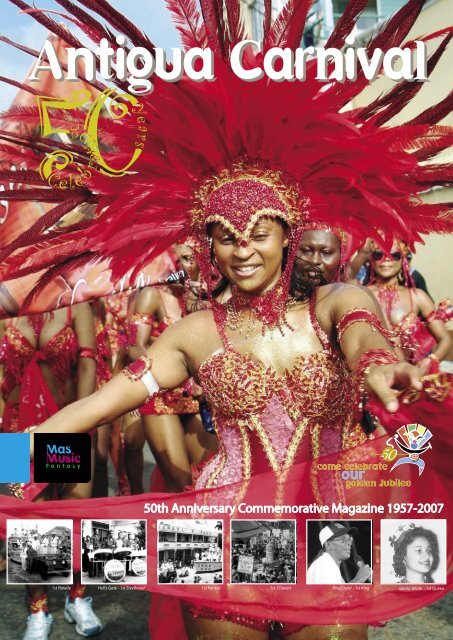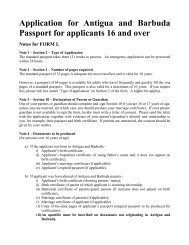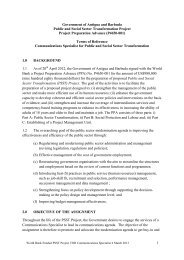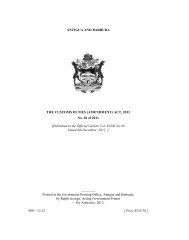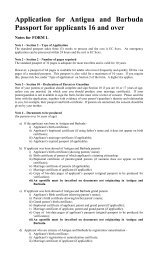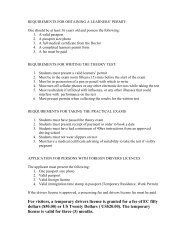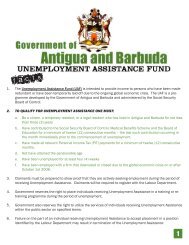AD - Antigua & Barbuda
AD - Antigua & Barbuda
AD - Antigua & Barbuda
- No tags were found...
Create successful ePaper yourself
Turn your PDF publications into a flip-book with our unique Google optimized e-Paper software.
come celebrateourgolden jubilee
BOA 20209 Ad for Carnival 6.5 x 5.2 7/3/07 3:08 PM Page 1Celebrate Carnival’s Golden Jubileeand a shining vision of the future.© 2007 Bank of <strong>Antigua</strong> Limited• 24-hour ATM machines• Four convenient locations• Bank on Wheels• Three branch offices• Change currency• Cash travellers cheques• Transfer funds• Get quick cashThat’s My BankAirport Boulevard • High & Thames Streets, St. John’s • Nelson’s DockyardTel: (268) 480-5300 • Fax: (268) 480-5433 • bankofantigua.comOpen 6 Days a Week
messagesHIS EXCELLENCY THE GOVERNOR GENERALSIR JAMES B. CARLISLE GCMG, KGN, GCQS, KStJI had not yet arrived at my twentieth birthday whenCarnival started in <strong>Antigua</strong> in 1957. My peers andI were extremely excited about the fact that <strong>Antigua</strong>was going to have a Carnival like the larger countriessuch as Trinidad. Many of the folks from the largerislands reminded us, at every opportunity that wewere from the smaller islands. The notion of having aCarnival like Trinidad gave us a sense of importance.We felt we had arrived.The schools and community groups took part inCarnival in the early days of the festival. There wasintense competition to see who could reproduce themost authentic historical characters. The Steel Bandsformed the backbone of the festival but we had veryfew Calypsonians. Hence, a number had to beimported from Trinidad.It wasn’t long before our Steel Bands and Calypsoniansheld their own with the best that Trinidad could offer.Perhaps the biggest noticeable change is the vulgaritywhich characterises today’s Festival. Our Carnivalwas meant to celebrate our Emancipation which tookplace on 1st August, 1834. Since then, our country hasadvanced to the point where our Colonial Masters feltthat we could run our own affairs. It would indeed bea wonderful thing if the 50th Anniversary of Carnivalwould reflect the achievements of our country. If thisis the focus in future years then our young peoplewould get a better understanding of who they reallyare. They would then seek to emulate the men andwomen who have made <strong>Antigua</strong> and <strong>Barbuda</strong> whatit is today.PRIME MINISTERHON. W. BALDWIN SPENCERA warm welcome to all our visitors, friends andreturning nationals to <strong>Antigua</strong> for this our GoldenJubilee celebration of the “Caribbean’s GreatestSummer Festival — <strong>Antigua</strong>’s Carnival.The 50th Anniversary of Carnival is of greatsignificance to the preservation of culture in <strong>Antigua</strong>,especially coming on the heels of the commemorationof the 200th Anniversary of the abolition of the BritishEmpire Atlantic Slave Trade, when we remember thestruggles and accomplishments of our forefathers.During these weeks of celebrating the music, masand fantasy that have made our summer festival theyardstick by which all other summer festivals in theeastern Caribbean are measured, we honour thosewho have given unselfishly to the development ofCarnival. We salute the founding men and women ofmas, steelband, calypso and pageants.We also salute our many benefactors and the scoresof contestants who have graced the Carnival stage inthe true spirit of promoting and preserving our cultureand exhibiting the remarkable craftsmanship of ourpeople. You deserve our highest commendation.On behalf of the government of <strong>Antigua</strong> and <strong>Barbuda</strong>I wish all revelers, mas builders, contestants andorganizers a fun filled and safe Golden Jubileecelebration. May we all experience the vibrancy,passion and excitement that is <strong>Antigua</strong>’s Carnival. Letus all celebrate in peace and harmony.Happy Carnival!6MasMusicF a n t a s y
come celebrateourgolden jubileeSTE<strong>AD</strong>ROY C.O. BENJAMIN, M.P.LE<strong>AD</strong>ER OF THE OPPOSITIONCarnival 2007 closes the first chapter of this Nationalsocial event which has been tagged, the Caribbean’smost popular Summer Festival. Most naturally andlogically, this important milestone must be a time forreflection. The question that begs the obvious answeris, how has the first half century of this cultural activitybenefited the people of <strong>Antigua</strong> and <strong>Barbuda</strong>?Carnival, we are told, is a time for celebrating ouremancipation from slavery; but is this fact really true?If not, why not?During this period of growth and development, it isquite evident that much has changed. I am honestwhen I state that every aspect of Carnival activity andinter-action among nationals, residents and visitors tothe State alike has changed for the better.As a people and Nation, there is much more unitingus than that which divides us. We have regularlydemonstrated that, when put to the test, we can worktogether to lift up the Flag of this Nation. I implore you,my fellow patriots, at this time, let us come togetherto build upon the foundation of the past 50 years andleave for our successors, a festival that truly reflectsthe best of what we are as a people and Nation andwhat we have to offer in the field of culture, talent andartistry.I offer warmest congratulations to the CDC and allCarnival revelers. Sincerest congratulations on thisthe Golden Jubilee.MINISTER OF TOURISM, CIVIL AVIATIONCULTURE AND THE ENVIRONMENT WITHRESPONSIBILITY FOR CARNIVALHON. HAROLD E. LOVELLFrom its humble beginnings in 1957, Carnival hasremained a time when we embrace our culture, ourheritage, our arts and most importantly our freedoms.Our Carnival encompasses who we are, as <strong>Antigua</strong>nsand <strong>Barbuda</strong>ns. Whether we live at home or abroadwe feel it in the air, before it arrives. And during thelast week in July to the first week in August, we revelin the music, mas and fantasy affectionately known as“The Caribbean’s Greatest Summer Festival”.On the first Monday in August, just as in 1834 when ourancestors took to the streets to celebrate their first dayof freedom, we too take to the streets of St. John’s tocelebrate our release from modern day restrictions.In their glory, formidable john-bulls join emerging bluedevils in creating a scare at J’Ouvert, as spectators“chip” to traditional iron and steel band music mixedwith now popular jam band sounds. “Kaiso, SweetKaiso” echoes from lips that acknowledge the cleverpun of seasoned and novice Calypsonians.And whether Talented Teens, Queens of Carnival,Calypso Monarchs, Soca Monarchs, PanoramaChamps or spectators – we pay tribute.As Minister responsible for Carnival, I wish for you,<strong>Antigua</strong>ns and <strong>Barbuda</strong>ns, and all our visitors amemorable experience and a safe and enjoyable 50thAnniversary of Carnival.I invite you to join us as we showcase our festivetraditions and create new ones.
messagesCHAIRMAN OF THE CARNIVAL DEVELOPMENT COMMITTEEMR. NEIL COCHRANETizzy does a fantastic job of capturing the emotionsCarnival evokes in this year’s My Carnival, when shesays: “I love to see my country, in the last week ofJuly. I love to feel the energy and I love to feel thevibe. I love to see the children; I love the way it feels.It’s like a picture painted perfect portrayed right outmy dreams ...”Carnival is the time of year when creativity bloomsin mass proportions. Pageant contestants go throughtheir paces; calypsonians, their songwriters, thearrangers and the musicians capture the mood ofthe country in song; the steel bands work magic inthe pan yard; mas’ builders take their concepts fromtheir heads to the paper to the theatre on the streets;the jam bands provide the infectious rhythms that willbecome indelibly intertwined with treasured memories;and the masses revel in the gaiety and splendour ofit all. Without a doubt, <strong>Antigua</strong>’s Carnival is a specialevent on the country’s calendar.This year, we are celebrating our fiftieth anniversary– the Golden Jubilee – and it is an honour and aprivilege for me to be the Chairman of the CarnivalDevelopment Committee (CDC) as we mark themilestone.That we would have gotten to this point is a given.Once inaugurated, there was, I am certain, anunspoken pact that <strong>Antigua</strong> would celebrate Carnivalinto perpetuity. As man holds no power over thepassage of time, equally important in arriving at thehalf-century mark is how we arrive at the destination.If Carnival were a woman, she would be a wise, regal,grand dame. <strong>Antigua</strong>’s Carnival has boasted of beingthe greatest summer festival, setting thestandard for others to follow. It has been the platformupon which many of the island’s most celebratedartistes perfected their craft and became legends,winners and household names.Carnival has kept us up late at nights, to see and hearwhat would be released; on the edge of our seats,to see who would be crowned; and she’s helped toput this county on the map, for the artistry and therevelry.There have been good times and there have beenlessons. We can boast of having held pride of placeand of regaining ground as we work collectively toreach the summit again.I salute all of the people who make the event happenannually – from the enterprising participants, to therespective committees that are manned by dedicatedvolunteers, to the hardworking people whosesubstantive job it is to look after the festival, to thespectators who fill the stands, line the streets and spurthe artistes on, to the sponsors whose commitmentsare Carnival’s backbone.On the occasion of our fiftieth anniversary, I wouldalso like to take a moment to salute the pioneers onwhose shoulders we stand and whose visions havebeen entrusted to us.To transplanted <strong>Antigua</strong>ns and other visitors here forthe Golden Jubilee celebrations, welcome. To eachand every one, have an enjoyable and safe Carnival.10MasMusicF a n t a s y
<strong>AD</strong>ABBOTTSJEWELLERY
12<strong>Antigua</strong>’s Carnival is a stunningspectacle of mas, music and revelry,which is a celebration of the island’slocal culture and its historic past,showcased in a blend of modernrhythms and African traditions,embodying the energy of the people.by Tracelyn A. CorneliusAlthough theyear 1957 wasthe officialbeginning ofcarnival, there wasa very effectivecarnival celebrationin 1953, which wasorganized tocommemorate theascension to thethrone of her majesty,Queen Elizabeth II.In recognizing a half century ofexistence, it would be amiss not toexpound on the birth of this jubilantseason, where the hardships ofliving are left behind as the nationcelebrates life and freedom.<strong>Antigua</strong>’s Carnival has quite aunique history and while the idea offreedom is implicit in the celebration, there were anumber of other factors surrounding the manifestation of the event.Indeed, it was the Coronation of Queen ElizabethII on June 3rd 1953, which provided theinspiration for the annual festival in <strong>Antigua</strong>.Back then, <strong>Antigua</strong> and <strong>Barbuda</strong> was stilla colony of Great Britain and was among afew other islands that organized a Carnival tocommemorate the event.A committee of noted personalities led by theChairman of the Tourist Board, thelate Sir John Ferdinand Shoul,organized the celebration that sawmany local spectators lining thestreets of St. John’s, transfixed, asthey watched the kaleidoscope ofcolourful artistic floats, groups andtroupes and listened and dancedto the sweet sounds of brass andsteelband music.The vibrant splendour ofthe coronation left quite an impression onthe people and quickened the desire forthe island’s very own annual festival. Priorto the official Carnival in 1957, individualsfrom the Point Community were alreadycelebrating a Carnival like festival duringthe Christmas season, where the mocojumbies, masqueraders, clowns andthe John Bulls took center stage, whilethe Iron and Steel bands accompaniedthe revellers. What’s more, the leadersof the combined steel and brass bands, who visited neighbouringSt. Thomas to play for their annual festival, saw the need to create asimilar event in <strong>Antigua</strong>.MasMusicF a n t a s ySelvyn WalterAccording to local author, historian and former Ministerof Carnival, Selvyn Walter, “some members of theHell’s Gate Steel Orchestra discussed the ideawith the late Howell Ambrose, who was a musicianand owner of the Ambrose Variety Band.” HowellAmbrose agreed with the concept, but realizingthat they would not have the necessary financialresources to carry out such a gargantuan task, hepersonally contacted a local businessman, the late
Maurice Michael. So impressedwas he with the venture that hediscussed the idea with FerdinandShoul, who had managed to pull offthe Queen’s Coronation Carnivalthree years earlier.And so in 1956, HowellAmbrose, FerdinandShoul, MauriceMichael and a fewof the committeemembers, who wereinvolved in the Queen’sCoronation Carnival, aswell as the late Sir VereCornwall Bird, who wasChief Minister of <strong>Antigua</strong>and <strong>Barbuda</strong> at the time,and the late Oscar Mason,a well known musician, andothers, commenced furtherdiscussions for the grand festival in1957.“ today, children areborn into Carnival, butthe founding fathershad to travel fromvillage to village tothe various councils,explaining therationale behind thecelebrations until theyeventually garnereda reasonable amountof support from thepeople.”The meeting to initiate preparationsfor the event was held in 1956 atthe Deluxe Cinema. And, although,there is no complete record of theattendees, it is widely believed thatSir John F. Shoul, Howell Ambrose,Maurice Michael, the late Edie HillThibou, Ruth Ambrose, the lateJoe Fernandez, the late NovelleRichards, the late ClarenceJohnson and the late PhillipLabadie were among the list ofpersons invited to the meeting.The group felt that Shoul beinga member of the Tourist Boardwould have more clout in gettingthe government to authorize thefestival, as well as source financesto stage the event. He had thearduous task of convincing theauthorities that hosting the festivalwould provide themeans of encouragingnot only <strong>Antigua</strong>ns inthe diaspora to returnhome, but attractingtourists to the islandduring the slowmonths as well.Although sugarproduction was ona steady decline,the planters,who still maintained a largedegree of political influence, wereconcerned that the celebrationswould affect the crop. The SugarBarons felt that holding a Carnivaljust prior to the end of the seasonwould disrupt production and incurserious losses to the industry.Shoul had to assure them thatthe sugar crop would not bejeopardized in any way.Maurice MichaelAfter several meetings withgovernment officials and thelate Alexander Moody-Stuart,who was the general managerof the <strong>Antigua</strong> Sugar Factoryand his colleagues, Shoul wasable to persuade them that if theTuesday after August Monday(Emancipation Day) was declareda public holiday, it would be anincentive for the workers to reapthe crop early.Here lies the reasoning behindthe three-fold purpose ofinitiating the official Carnival in1957: (1) a sort of ‘crop over’celebration, representing a midyearbreak after a hard six monthsof work in the sugar cane fields(2) the commemoration of theemancipation of slavery and (3)an attraction to induce visitors to<strong>Antigua</strong>.Today, Carnival is anticipated withmuch zeal, but back then, theinterim committee had to sell theidea to the people. As one of theearly pioneers of the festival DameYvonne Maginley tells it, “today,children are born into Carnival, butthe founding fathers had to travelfrom village to village to the variouscouncils, explaining the rationalebehind the celebrations until theyeventually garnered a reasonableamount of support from the people.”Financing the festival seemed tobe an insurmountable challengeand many of the pioneer membersof the Carnival Committee claimedto have borrowed thousands ofdollars from the local banks to getthe first official Carnival off theground. Additional research alsoreveals, that Maurice Michael wasinstrumental in securing some ofthe finances, while Oscar Masonalso assisted by organizing weekly‘Brams’ (dances) at Michael’sMount to raise money.By early 1957, most of thechallenges surrounding the eventwere sorted out and a meetingwas held at Princess ElizabethHall, (located where the nationalArchives building now stands)where the inaugural Carnivalcommittee and sub-committeeswere elected.The then Minister of SocialServices, the late Hon. EdmundLake, convened the meeting, whereShoul was elected as the firstCarnival Committee Chairman. Theelected subcommittee chairpersonswere the late Rita Anjo (Queen’sCommittee) Dame YvonneMaginley (Children’s Carnival)and the late George Martin(Calypso Competition). Otheractive members included NovelleRichards, Phillip Labadie, Gilbert“Big U” George, Ruth Ambrose,Joseph Robinson, Basil Breton andEdie Hill Thibou.come celebrateourcontinued on p14golden jubilee
14The Originsof Carnival- cont.The first Carnival was a miniatureversion of what the festival istoday. Whereas today, Carnivalembraces a series of unforgettabledays and nights filled with variousparties and shows, ranging frommusic competitions to severalpageants, fifty years ago, the onlycompetitions were the Queen andCalypso Shows held at the DeluxeCinema. These were followedby a parade which featured anumber of brightly coloured andattractive floats sponsored bythe business community. Eventhough the creativity and style ofthe troupes and groups presenteda magnificent medley of coloursthat was a sight to behold, it wasnothing to compare with what isdisplayed today.Indeed, Carnivalhas evolvedinto a frolicking,financially viable,merry-makingannual event,more glamorousand excitingeach year.The birth of <strong>Antigua</strong>’s Carnivalwould not have been possiblewithout the dedicated work of agroup of good spirited citizens,who whether directly of indirectlycontributed toward its success.Among the names that shouldbe recognized, respected andremembered are Gilbert “Big U”George and Phillip Labadie, whowere outstanding workers. Thelate Hilson Murdoch, Jasper“Bobby” Scotland, the late Dr. JoeRobinson, and the late KenrickTully, were members of thecommittee for years.MasMusicF a n t a s yThe contributions of the late JillWalker, who designed the firstCarnival stage and Amos Morrell,who continued where she left off,must always be remembered. St.Clair Baston of the Public WorksDepartment, who built the firststage at the Recreation grounds,Pat Starr whose idea it was tointroduce Carnival City, and herhusband Ogden Starr must neverbe forgotten. The late DenfieldHurst was considered by many tohave been one of the most effectivefinancial comptrollers.Dame YvonneMaginley chairedthe QueensCommittee formany yearsalong with theassistance of LadyMarie Shoul, RuthAmbrose, MyrnaKelsick and JudyJohnson, amongothers. Many peopleare unaware thatWilkin Griffith was the only maleto chair the queens committee.Gwen Tonge and Edie Hill-Thiboucoordinated the Children’s Carnivalfor many years in addition toassisting in many other areas of thefestival.And, where would Calypso in<strong>Antigua</strong> and <strong>Barbuda</strong> be today,without the sterling contributions ofthe late George Martin and JuliusMarcus Christopher, who alsoplayed a major role in the overalldevelopment of calypso and mas.Hon. Emmanuel Lake served inmany capacities as well as St.Clair Allen, Morella Wilson, SamBenjamin, Reginald Knight, LounelStevens, Gerald Price, FrankAgard, Thousand (the blacksmith),Reginald Cornelius, Len Ablackof Trinidad and Tobago, Clarenceand Helen Johnson, GeorgeKelsick, Reginald Samuel andEdward T. Henry. Ralph Murphygot the troupes and groupson the road for many years.Maurice Michael, who startedthe first Jaycees Chapter on theisland, introduced the JayceesQueen Show, adding a soughtof regional flare to the Carnivalcelebration.Dame Yvonne MaginleyMany others have made their markon the celebration over the yearsand special mention must alsobe made of Selvyn Walter, whointroduced the Teenage Pageantcompetition in the early seventiesand is also the founder of theHalcyon Steel Orchestra.Indeed, Carnival has evolvedinto a frolicking, financially viable,merry-making annual event, moreglamorous and exciting each yearwith the quality of the competitions,parades and shows, aswell as the spectacularcultural and dramaticmusical events.This year, as <strong>Antigua</strong>celebrates the GoldenJubilee of this greatfestival, Carnival, it ismy fervent wish thateveryone, citizens,residents and visitorsalike, enjoy awonderful and funfilledsummer festival.To all those, who have contributedover the years, I am sure that every<strong>Antigua</strong>n and <strong>Barbuda</strong>n will join mein saying ‘thank you.’Lord Melody in 1957,<strong>Antigua</strong>'s First RoadMarch King - Song:"Your Crazy,Crazy Love"
<strong>AD</strong>APUACELLULARcome celebrateourgolden jubilee
Leroy “Jughead” GordonIn 1945, <strong>Antigua</strong> and <strong>Barbuda</strong>experienced a new culturalphenomenon, the steelpan,which later heralded the steelbandmovement, which was piloted byindividuals who lived in someof the most depressed areason the island.was credited with bringing the firstpan into <strong>Antigua</strong> from Trinidad. Thepans built in Trinidad were moreadvanced than the ones built in<strong>Antigua</strong>, and as the new inventionin music travelled across the island,the race was on to make somethingsimilar to the ones built in Trinidad.At that time, no rubber accompaniedthe sticks that the players used tobeat the pans with in <strong>Antigua</strong>, eventhough later on, a ball of rubberbands at one end of the stick wasintroduced to beat the notes.16In those days, the refineriesin Curacao offered the bestopportunities for people from<strong>Antigua</strong> and the other islands interms of employment, so there wasa steady movement to and fromboth islands by boat which was themain source of transportation at thetime. However, on a return trip to<strong>Antigua</strong> on “Lady Boat,” which was apassenger and cargo vessel, a stopin Trinidad to refuel was where afew <strong>Antigua</strong>ns first heard the sweetsounds of the steelpan. They werefascinated by both the instrumentand its sound and vowed to take thisMasMusicF a n t a s ycultural innovation back to <strong>Antigua</strong>and <strong>Barbuda</strong>.On returning home and reporting thegood news of what was happeningin Trinidad musically, a few menin the Point area who had earlierdeveloped the “iron band” from oldpieces of iron, scrap metals, hubcaps, old tin pans and sticks whichwere discarded at the dump site,which is now home to the Port,decided to begin work on building asteelpan. Made from an empty steeloil drum, cut off in varying lengths toemit a range of tones, the pan is putthrough a process of hammering andheating, thus achieving a chromaticsound. Busta Carty from the Pointarea, who was very impressed withthe steelpan and the sound it created,When the first steelband, Hell’sGate, from the Point area made itsway uptown one Saturday morningplaying “My basket, my basket,my green and yellow basket,” afterweeks upon weeks of rehersalsunder the tutelage of arranger,Alexander “Alec” Roberts, theresponse was so overwhelming, itbrought people into St. John’s fromall around the island to see and hearthe new phenomenon in music. Atthe time, the instrument was hungwith a strap around the neck of eachbandsman thus creating a certaintype of mobility. This allowed thesteelband to travel around the townwith ease. That was the official birthof pan and its music into the annalsof the <strong>Antigua</strong>n/<strong>Barbuda</strong>n culturalexperience.
"at that timeno rubberaccompaniedthe sticks"It was not too long that a secondsteelband, “Red Army” was formed byCharles McCarty in the Grays Farmarea. The band was sensational,and to date, has produced one of thebest pan players ever, a gentlemanby the name of Walton Herbert.Later the same year, “Brute Force,”hailing from the South Street (PigVillage) area, was formed by EarlJones. The band received widerecognition at the time and over theyears was able to boast of the skillsand capabilities of Llewellyn Howell,known to many as “Welly” andthe extraordinary pan enthusiast,Arthur “Bum” Jardine. These guystook Brute Force band to heightsunimaginable in the steelbandworld.All three bands, Hell’s Gate, RedArmy and Brute Force, coming fromsome of the poorest communitieson the island, fostered a sense ofcompetitiveness and an aggressiverivalry that only a competition couldquell. The rivalry among them wasso pronounced that a steelbandcompetition was planned to establishwhich was the best steelband in<strong>Antigua</strong> and <strong>Barbuda</strong>. Just beforethe contest, another steelband wasformed on the sister isle, <strong>Barbuda</strong>,which carried the name of “GoldenGate.”At the first Steelband competitionin 1949, which was held at the“Girls School,” individuals placedbets on their favourite band, andthe competition fever became veryexplosive. Every band playedthe song, “Peanut Vendor” whichwas the test piece selected for thecompetition. Hell’s Gate with morespirited and skilled players emergedthe winner, with Red Army and BruteForce placing second and thirdrespectively.Right after the competition, thepeople in the Barnes Hill/NewWinthropes community decided thatthey too should have a steelbandand before year’s end, “NorthStar” steelband was formed. Atthe time, men like Edric Robinsonand Samuel Simon (father of Dr.Lester Simon) were the movers andshakers in the community steelbandmovement. Soon after, the villageof Pigotts boastfully followed whenit introduced the “Rising Sun”steelband. Rising Sun became verypopular and had a cast of youngand talented men, and in 1952, withJoshau James as captain, they wereadjudged Steelband Champions withtheir rendition of “C’est Si Bon.”Other steelbands formed during thatperiod were Blue Skies, Manpower,Sun Valley, Golden West, LoneEagle, Cardica, Duke of Iron,Wayward Force, Star Dust, Big Shelland Nightingale.During the period 1948 to 1959, BruteForce as an established steelband,played at the Anchorage Hotel andthe <strong>Antigua</strong> Pelican Club. Theymade trips to Dominica, Puerto Rico,<strong>Barbuda</strong>, Jamaica and Barbados,and it was touted about that <strong>Antigua</strong>steelbands had surpassed those inTrinidad and Tobago. Panmen whowere masters of the art atthe time were continuallyexperimenting with thepan, and names likeEustace “Manning”Henry, Arthur “Bum”Jardine, Llewellyn“Welly” Howell, Dennis“Nunny” Byam,Dennis Lashley,Cowboy, Bruce“Fundo” Bloodman,Chisland, SeldonEdwards andothers werehailedmasters of theart. They couldasplay any pan from treble, doubletenor, double second, bass, etc.Bruce “Fundo” Bloodman, who hassince passed on, made such animpact in St. Thomas on Hell’s Gatefirst trip there, that many people whoheard him play, decided to renamethe double tenor pan – the “Fundopan”.In 1952, the first ever all-girlssteelband, “The Pastel Intruders”was formed. The group of young,exciting and energetic ladies,exhibiting skills on pan on par withtheir male counterparts, won thehearts of <strong>Antigua</strong>ns/<strong>Barbuda</strong>nsand others when they played attheir first official function in 1953 tocelebrate the coronation of QueenElizabeth II. The names of the bandmembers were Carmen Jardine, theCarmichael girls, the Heath girls,Mrs. Murray, the Pigotts girls, Dulcie,Jean and Audrey. They were tutoredby Arthur “Bum” Jardine and the lateVere Griffith. However, the band didnot have a long history.Hell’s Gate, the leading steelbandat the time, would be invited toplay at social functions held atthe Government House, ClarenceHouse, and other places on theisland. They were assisted by oneof <strong>Antigua</strong>’s qualified musicians, thelate Bertha Higgins, who arrangedmany of the carols and classicaltunes that they played. It was apleasure to witness a group of youngmen, well attired in their frilled steelband shirt and a platted straw hat,with their instruments hanging fromtheir necks, engaging those wholoved and appreciated the art formcontinued on p18come celebrateourgolden jubilee
to dance. It’s reported that manyindividuals in the privileged classat the time stayed away from thosefunctions as pan and its players didnot enjoy the level of acceptancethat they now enjoy today.In 1948 Hell’s Gate was invited toplay at the opening of the Mill ReefClub, and when the palm-fringed<strong>Antigua</strong> Beach Hotel opened itsentertainment package one nightwith the Hell’s Gate steel band,natives and tourists alike wereflabbergasted to see and hear asteelband playing in a hotel. In 1950,Hell’s Gate performed at the St.Peter’s Anglican Church in Parham,making it the first steelband to play ina church in <strong>Antigua</strong> and <strong>Barbuda</strong>. In1963, another steelband, South SideSymphony, captained by DenleySamuel, had the honor of playingin the St. John’s Cathedral for aChristmas program. This was verycontroversial. The Choir master andorganist at the time was Mr. Jarvis,who was adamant that the Cathedralwas not the place for a steelband.It was Dean Baker who intervenedand asked Mr. Jarvis to go and listento the steel band. After listening toa few of their renditions during apractice session, which were mainlyChristmas carols, Mr. Jarvis was soimpressed, the way was cleared forSouth Side Symphony to play in theSt. John’s Cathedral.As pan progressed, it was a momentin history for all <strong>Antigua</strong>ns and<strong>Barbuda</strong>ns in 1955, when <strong>Antigua</strong>was hailed as the first place inthe Caribbean where a steelbandr e c o r d i n gwas done.The bandwas “BruteForce” andthe nameof thealbum was“ B e a u t yand theBeast.” Soon after, anotherrecording was done. It was entitled,“Steelband Clash” featuring Hell’sGate, Brute Force and North Starssteelbands.Men like Leroy Silston, who was theChairman of the <strong>Antigua</strong> CarnivalSteelband Programme for manyyears, and who assisted a number ofpersons in the steelband movement,has been credited with “This Land”by Intrade Harmonites and “DiscoSteel” by Halcyon, which are two ofthe more popular recordings doneby <strong>Antigua</strong> steelbands.In 1958, the Government of Trinidadand Tobago invited Hell’s Gate toperform in Trinidad. The steelband’sperformance on tour was rated assuperb, making the Trinidad panmena little jealous. Even though thebands in Trinidad were much bigger,the rhythm section of Hell’s Gate wasmuch sweeter and the players weremore exciting to watch on stage.The next year, 1959, Brute Forcewas invited to Trinidad and they tooenjoyed wide exposure when theirmusic was played on radio stationsacross Trinidad. Radio Guardianused Brute Force’s recording “Underthe double Eagle” as a ‘sign on’ and‘sign off’ song.In 1960, the first steelband fromTrinidad, “Pan Am North Stars”performed in <strong>Antigua</strong> at the <strong>Antigua</strong>Recreation Ground. The eventwas not properly advertised and adisappointing small crowd showedup. The band played a variety ofsongs and it was quite evident thatthe crowd did not appreciate theirversion of calypso music. Therhythm was not what was expected.Also in 1960, when the late SirWinston Churchill visited <strong>Antigua</strong>aboard the Yacht “Christina” ownedby the Greek tycoon Ari Onassis,Hell’s Gate steelband providedthe entertainment on board theyacht that was docked at Nelson’sDockyard.As pan music gained prominencein <strong>Antigua</strong> and <strong>Barbuda</strong>, andthroughout the Caribbean with thedevelopment of Carnival, the 1960’ssaw the beginning of a number ofsteelbands, most being off-springs ofexisting, established bands. Amongthe new bands were Red Streak,West Side Harmonites, South SideSymphony, Buccaneer Cove Pirates,Jr. Hell’s Gate, Texaco Astronauts,St. Joseph’s Academy Steel Band,and two all-girls steelbands, theCosmonauts (an off-spring of TexacoAstronauts), and the Melonites(an off-spring of Harmonites). The1960’s also saw the emergence ofmany great pan players, some whohave migrated, while others arestill among us today. Some of thenames that come to mind are RoyGomes, Rawdon Edwards, Franklyn“Cockwheel” Byers, Willy Jeffrey,Stacey Edwards, Victor Michael,Phillip George-John and TrevorMathurin. Roland Prince, a worldclass musician, arranged for BruteForce at the tender age of sixteen(16). Quite an accomplishment.In 1964, Hell’s Gate won theSteelband Championship title.Dr. Foster Hill, one of <strong>Antigua</strong> and<strong>Barbuda</strong>’s best musicians, arrangedthe title piece and worked tirelesslywith the band night after night formany weeks seeking perfection ofthe masterpiece. On competitionnight, many people wept openlywhen the band performed Handel’s“Hallelujah Chorus”. It was a18MasMusicF a n t a s y
moment of glory for not only Dr. Hill,but also for Eustace “Manning” Henrywho had assumed the captaincy ofHell’s Gate from George “Nugget”Joseph, who had captained theband to the Championship titles in1953, 58 and 59 with arranger andmusician Sydney Prince, anothermusical master.The same year, Hell’s Gate wona prize trip to New York’s World’sFair, donated by British West IndianAirways (BWIA). In New York, theyheld large crowds spellbound, whocould not believe the sounds thatemanated from a set of oil steeldrums, particularly at the Caribbeanpavilion, as they masterfully executedtheir renditions which ranged fromcalypso and ska to classical music.Between 1965 and 1967, twoTrinidadian steelbands were invited to<strong>Antigua</strong>. “Shell Invaders” was the firstin 1965, and has been credited as theband that introduced the cello pan to<strong>Antigua</strong>n and <strong>Barbuda</strong>n panmen.In 1967 “Esso Tripoli” steelbandvisited <strong>Antigua</strong> on two occasions.It was a period when the <strong>Antigua</strong>npanmen began to fully appreciatethe sounds of the used oil drums andBrute Force was the first steelbandto engage the services of a pan tunerfrom Trinidad. The band dissolvedsometime in 1968-69.The decade of the 1970’s openedwith “Rising Sun” captained byVincent Freeland, and with Dr. CharlieRoberts as arranger, the steelbandwalked away with the SteelbandChampionship title that year. Theonly other bands in the 70’s who werefirst time championship winners wereSupa Stars (1973), Halcyon (1975),and Ebonites (1977). This period hasbeen touted as the best era that panhas enjoyed thus far in <strong>Antigua</strong> and<strong>Barbuda</strong>.Other bands formed during the1970’s and 80’s were Supa Fly,South Stars, Cedar Sonics, Barclay’sAll Stars, Angas Tri Stars and theall girls Symphonettes, Petro Steeland Metrophonics. Many individualpannists also came to the fore likeAubrey “Lacu” Samuel, Fitzroy“Champ” Martin, Victor “Babu”Samuel, Patrick “Stone” Johnson,Veron Henry, Simon Tulon, Curtis“CC” Cochrane (the four stickmaster), Kemoye “Congo” Thomas,(the three stick master), CharmaineDeSouza, Vincent Michael, RobinA. L. Margetson, Stephen Mason,Fitzroy “Blakie” Phillip, StaffordJoseph, Marlon Charles, PatrickWatkins, Daulton “Dally” Francis,Lingfield “Cujo” Martin, Professor,Kamoy, Gary, Kodjo, Woto, Geran,Wadada, Zulu, Shwarp, Stove andSnagga.In 1981, a group of young, talentedplayers known as the “Gemonites,”formerly PM Serenaders, captainedby Vere Henry, walked away with theSteelband Championship title thatyear. 1981, 1985, 1986 and 1987 werethe only four years of the 1980’s thatSteelband Competitions were held in<strong>Antigua</strong>. In 1985, Harmonites werethe champions, in 1986 and 1987,Halcyon won both championships.To date, steelbands have sprung upin quite a number of countries outsidethe Caribbean like China, Japan andSweden, and the significance of thesteelpan in the emergence of worldmusic is testament to the fact thatsteelband music is now accepteduniversally.Lately, the steelpan in <strong>Antigua</strong> and<strong>Barbuda</strong> with its original and uniquesound is almost lost to the loud hifi’s and jamb bands which dominatethe music scene during the Carnivalcelebrations.come celebrateourgolden jubilee
<strong>AD</strong>BELMONTCLINIC20MasMusicF a n t a s y
Steel BandGreatsEustace “Manning” Henry -- A giant in the steelband movement, he is regarded asone of its pioneers. Manning assumed the captaincy of Hell’s Gate Steel Orchestrain 1964 and remained as its captain and manager for many, many years. He is anoutstanding pan builder, player, tuner and captain. One of his shining moments wasin 1997 when he and his son Veron were invited to Aruba to assist in the revival ofsteelband music on the island. In 2002, Manning was inducted into the Carnival Hallof Fame.Bruce “Fundo” Bloodman – Another pioneer of pan, Fundo, who was born onNovember 6, 1932, was one of the leading members of the Hell’s Gate Steel Ochestrain its early days. He joined the band along with his companions, George and ElickWilliams and travelled with the band on various trips abroad. On one such trip to St.Thomas, his performance on the double tenor pan was so impressive that many calledfor the re-naming of the double tenor as the “Fundo tenor.” He resided in St. Thomas fora number of years and formed the “Charlotte Amalie High Shooting Stars” steelband. Hehas inspired many young pannists, and who can forget his solo presentation of “Cantata”which is forever etched in the minds of many pan lovers. Over the years he has beenassociated with Harmonites, BPL Supa Stars, Rising Sun and his own steelband, “FundoSerenaders” which he formed in 1968. In 2003, Fundo was inducted into the CarnivalHall of Fame. He has since passed on.Eustace “Gatouks” Harris – As a member of Stardust which was an offshoot of RedArmy, Gatouks spent a lot of time observing “Chisland,” who built pans for various bands,and from an early age, he became fascinated with pan building. In the late 1960’s he leftStar Dust to play with Brute Force, and was denied the opportunity to play in Panorama1968 with the band. Soon after, Gatouks, whose mindset was permanently fixed on panbuilding, left the band and started experimenting with his dream. Today, Gatouks is amaster of the art of pan building.Rupert “Teela” Parker -- A foundation member of Harmonites International SteelOrchestra, Teela, over the years, has served in the capacity as captain and arranger ofthe steel band. He has taught many in the Point and other areas around <strong>Antigua</strong> to playthe pan. A pioneer in the steelband movement, Teela captained Harmonites in 1968when they tied with Brute Force. He captain the band to their Championship titles in1971, 1972 and 1974. In 1968, he arranged ‘Miss Tourist,” the winning piece. With fourSteelband Championship titles in seven years, under his captaincy in 1974, Harmoniteswon the “band of the year” title, for their presentation of “Interplanetary Sailors,” a titlewhich is usually won by the number one Carnival mas troupe.Victor “Babu” Samuel – Hailed as one of <strong>Antigua</strong> and <strong>Barbuda</strong>’s best pan player andarranger today, Babu captained Halcyon Steel Orchestra in 1978 and 1979 when theywon their second and third Steelband Championship titles. In 1986 and 1987, the bandwon two other Championships, and in 1992, 1993, 1994 and 1995, they enjoyed thestatus of being the only band in <strong>Antigua</strong> and further afield to four peat in a SteelbandChampionship competition. Babu was the arranger during those glorious years.come celebrateourgolden jubilee
Steel BandGreatsSteadroy “Steady” Joseph -- The late cultural activist, Steady, as he was fondly called,touched the lives of many in the steelband world. In 1968, he was instrumental in thecreation of the Supa Stars Steel Orchestra and their ultimate road to victory some four yearslater. Steady was always willing to spread his knowledge and experience throughout thepan fraternity, and committed his life to the development and advancement of HarmonitesInternational Steel Orchestra. His favorite instrument was the double second pan and healso enjoyed playing the percussions.Veron Henry -- The son of the great pan player, pan builder and former captain of Hell’s GateSteel Orchestra, Eustace “Manning” Henry, Veron has decided to walk in the footsteps ofhis dad. He is a pan tuner, a pan builder, and can play just about any instrument in the steelband. In 2004, Veron along with Vere Elmes arranged the song, “Freedom Celebration” forHarmonites International Steel Orchestra which propelled them to the Championship titlethat year.Fitzroy “Champ” Martin -- An excellent pan player and arranger, Champ captainedHarmonites International Steel Orchestra in 1985 to victory when he arranged “Don’t EatIt,” a piece that the steel band played with all the zest and vigor one could muster up. Heis brother to the late, Beverly Roberts-Watkins, a member of the all girl’s steelband, the“Melonites.”George Weekes -- An true legend of the steel band movement, Weekes has been involved forover forty years. A master of the pan, he captained Harmonites International Steel Orchestra totheir first Championship title in 1969, after being tied with Brute Force in the 1968 competition.Weekes is also credited with playing a major role in the formation of the Melonites (all girl’ssteelband). When Nunny Byam built his first three steel pans, Weekes, Teela and Arthur Whitewere the recipients. Still an active member with Harmonites, Weekes remembers individualslike Hopsis, Joseph, Little, Playboy and Arthur White who started out with him in 1962.Curtis “CC” Cochrane -- CC started playing pan in 1975 and joined Ebonites in 1977. By1978, he started practicing with Halcyon Steel Orchestra, and by 1979, he was playing in hisfirst Panorama as a member of the steelband. That year, Halcyon won the Championship titlewith “Kangaroo Jam,” arranged by Len “Boogsie” Sharpe. CC has developed himself as apan soloist and enjoys working with some of <strong>Antigua</strong> and <strong>Barbuda</strong>’s best musicians. He playsthe pan with four sticks, which is a very rare occurrence in the scheme of things. He is surelyblessed with a wonderful gift.22MasMusicF a n t a s yDennis “Nunny” Byum -- Another pan pioneer, “Nunny” as he was called, was aquiet, but effective member of the pan movement. In the Point where he resided,Nunny was always building pans. His chisel and hammer were over-worked,but there was a special quality sound in his blending. Nunny had a tremendousimprovising ability that was unmatched. He was a pan player, a teacher of thepan, and a first-class pan builder. Nunny has since passed on – may his soul restin eternal peace.
Arthur “Bum” Jardine - As a youngster, Bum got involved in the steel band movement afterhis mother gave Brute Force permission to practice in the yard of her Cook Shop which waslocated on South and Market Streets. In the 1950’s and 60’s, he traveled extensively with thesteel band and became a solo artiste in 1957. He presently resides in the U.S., and today,is recognized as one of the best pan players that <strong>Antigua</strong> and <strong>Barbuda</strong> has produced. Anupcoming auto-biography entitled, “The Man, His Pan, and the Conflict,” that details the life ofthis great pan player will be available shortly.Pat Edwards -- One of the most sought after musicians in <strong>Antigua</strong> today, Pat Edwards is atthe top of his game. Since returning home, after a long sojourn in New York, Pat is still verymuch involved with music, even though it is not steelband music. An excellent pan player, in1961 he joined the St. Joseph’s Academy Steelband, and later played with Johnny Gomesand others in South Side Symphony and the Astronauts steelbands. He also arranged anumber of tunes for the Astronauts. Pat Edwards is in the class of a music genius.Simon “Kamau” Toulon -- made his debut in 1972 with the St. Joseph’s Academy Steelband.In 1973, he joined Harmonites International Steel Orchestra, and since then has served asits Treasurer, Secretary, Vice-captain and Captain. Since 1985 to present, he has captainedthe band. Toulon plays the low bass and when asked what has been his best moment withHarmonites, he was happy to talk about 1979 when the band was invited as part of theentertainment package for the US Super Bowl half-time show. Toulon would like to see musicas a part of the school’s curriculum, so that the youths would be able to read and appreciatemusic. He has toured extensively with Harmonites over the years and has visited places likeKorea, Canada, US, Brazil, Bahrain and Grenada.Aubrey “Lacu” Samuel -- A quiet, unassuming master of the pan, Lacu like brother Woto, lovesto play the double second pan. Many years ago at an <strong>Antigua</strong> Girl’s High School fete, Laculistened to Supa Stars, he was so captivated by them that he decided he wanted to play thepan. He started playing with Supa Stars in 1976 and was a member of Gemonites when theywon their first Championship title in 1981. Lacu migrated to the United States for a period of fouryears and while residing in Baltimore, Maryland, he joined Oliver’s steelband, the “Pace Setters.”Lacu returned home in 1987, and started developing himself as a solo pan artiste. In 1995, hejoined Roots Steelband and is still an active member with them. Lacu plays all the instruments inthe band, but the double second is his favorite.Valerie Harris-Pole – captained the all girls Melonites Steel Band which started in 1964in the Point area as an offspring of Harmonites International Steel Orchestra. The band’sfirst outing was the Labour Day Queen show which was held at the Michael’s Mount. Thetwo songs the band played were “Sweet Pea” and “Stricolene.” The band was also invitedto play at the Labour Day parade through the streets of St. John’s and at the picnic at FortJames. Other members of the band were Leonie Henry, Janet & Estella Williams, BrendaEphraim, Jacqueline King, Sandy Hunte and the late Beverly Roberts-Watkins.Judy Labadie – captained the all girls Cosmonauts Steel Band which started in 1965 in theOvals/South Street area as an offspring of Texaco Astronauts Steel band. Early members ofthe band were Heather Gomes-Bailey, Hazel Martin, Odette Mills, Rosey Longford, ValerieHodge, Harlene Williams, Janice Dover and Heather Longford.Dennis Lashley – an old veteran of pan, Dennis joined Hell’s Gate in the late1950’s and stayed with the band for many years. When his nephew, GeorgeWeekes, Teela and others formed Harmonites International Steel Orchestra in the1960’s, he immediately switched bands. He is one of the better bass players whohas played in many Steelband Competitions and has enjoyed a few Championshiptitles. He is still very active in the steelband movement today.come celebrateourgolden jubilee
Steel BandGreatsCharmaine DeSouza -- a talented, unassuming schoolteacher, pan was almost preordained.Her father, former Rising Sun player, Charles “Chicken” DeSouza, influencedCharmaine and her brothers to take up pan. As a young player and arranger, Charmaine’saspiration is to be the first female arranger to win Panorama.Patrick “Johnny” Gomes – A member of the now defunct Brute Force Steel band, ‘Johnny’,as he is affectionately called, is an experienced pannist who was tutored by one of the greatpan masters, Arthur “Bum” Jardine. Johnny is an accomplished musician who also playsthe keyboards, and is still very much involved with pan today. He is the present captain andlead tenor player of the popular City South Steel Orchestra based in the Bronx , N.Y. Thesteelband, recently released two popular CDs which feature an array of religious music. Formany years, Johnny taught pan successfully at Youth Interactions, Inc. in New York , which isa performing arts school and repertory company.Before migrating to New York , Johnny played with Brute Force, South Side Symphonyand Texaco Astronauts, which he captained. In November 1993, Johnny was awarded theInternational Heritage Award for his contributions and achievements to pan and music.Stephen Mason - made his debut in 1977 as a member of Harmonites InternationalSteel Orchestra. He joined Gemonites in October 1981 right after the band won its firstSteelband Championship title. However, he was present in 2003 and again in 2005 whenGemonites won the Steelband Championship titles. Stephen started out playing thesingle tenor, but is now a part of the band’s rhythm section where he plays the timbalesand drums. His motto in life is to always strive for excellence.Patrick “Stone” Johnson -- an ace pan player and arranger, Stone started playing pan with theSt. Joseph ’s Academy Rhythm Masters. In 1982 he joined the Gemonites Steel Orchestra andhas trained members of the band to play all forms of music. An arranger for over 30 years, he ispresently employed at the Cultural Development Division and has functioned in the past 15 yearsas Chairman and Secretary of the <strong>Antigua</strong> and <strong>Barbuda</strong> Steelband Association.Fitzroy “Blakie” Philip -- his interest in pan started in 1975 when Blakie was still a very youngteenager. He would visit the Halcyon pan yard but never got the nod to become a member of theband until 1977, when Victor “Babu” Samuel supported him to be an official member of Halcyon.Blakie plays the tenor pan and is an accomplished soloist and arranger.Ashley George – he joined Hell’s Gate in 1964 and is one of the best bass players around. As amatter of fact, Ashley is still a present member of the band. He was one of the original foundersof BPL Supa Stars along with Steadroy “Steady” Joseph and Dennis “Nunny” Byam. Ashley hastaught and trained many players, and has enjoyed many Championships with the band.Gary Bridges – joined Supa Stars during his days at the <strong>Antigua</strong> Grammar School anddeveloped his skills on pan to become one of the best pan players to date. In 1969 he migratedto Miami and returned to <strong>Antigua</strong> in 2006 to celebrate Lacu’s 30th anniversary of playing pandubbed “Pan Rising” at the Royal <strong>Antigua</strong>n Hotel. Gary is a first-class pan player and has beencredited as being Aubrey “Lacu” Samuel’s pan teacher. He is now a solo pan player in Miami.come celebrateourgolden jubilee
Steel BandGreatsStafford Joseph – as a student at the St. Joseph ’s Academy, Stafford made his debut in thepan world in 1972 after being encouraged by one of his teachers who, at the time, was a foundingmember of the Harmonites Steel Orchestra. Even though most of his schoolmates becamemembers of Harmonites, Stafford joined the oldest steelband on the island, Hell’s Gate SteelOrchestra, and is a master on the double tenor pan. Stafford loves classical music and in hisspare time he enjoys teaching pan and reading. He is presently the captain of Hell’s Gate SteelOrchestra and has a wealth of knowledge of the real ole time steelband greats. Stafford was veryhelpful in providing information to assist us to include as many individuals as possible. Thanks.Eugene Murphy – presently residing in the USVI, Murphy played with Brute Force steelband in 1963with other great pan players like Patrick “Johnny” Gomes, Arthur “Bum” Jardine, and a host of otherplayers. Murphy is still considered as one of the best cello players around.Daulton “Dally” Francis – started out in 1974 as a member of the PMS Serenaders (now Gemonites)under the captaincy of Vere Henry. In 1976 he joined Harmonites International Steel Orchestra and in1979, he became a member of Halcyon Steel Orchestra and enjoyed his first Championship title withthe band. A school teacher by profession, Dally is also an arranger. To date, Dally can boast of sevenChampionship titles with Halcyon.Lingfield “Kodjo” Martin – a pioneer in the pan movement, Kodjo got interested in pan at the tenderage of ten, and in 1971, he became a member of Harmonites International Steel Orchestra. By 1973,he was arranging for PMS Serenaders (Gemonites). In 1981 he was off to Carifesta in Barbados andin 2001, he arranged the tune for Harmonites and won the Steelband Championship that year. Kodjois father to the youngest female pan player, Chekiyah Martin , who started playing pan at age 4, and isknown as “The Pan Princess.” As an ace arranger, Kodjo is still making his contribution to pan. Kodjo’sbrother, Fitzroy “Champ” Martin, captained Harmonites in 1985.Ricky “Woto’ Samuel – brother to Aubrey “Lacu” Samuel started playing pan in 1973 with HarmonitesInternational Steel Orchestra. A boss on the double second pan, Woto has many Championship titlesunder his belt and is still playing today with Harmonites and arranges for the band as well.Elderfield Phoenix - another fine cello player. In 1965, Phoenix was one of the key players in TexacoAstronauts steelband that was captained by Patrick “Johnny” Gomes.Robert A. L. Margetson - fondly called “Robin,” was introduced to pan thirty-four (34) years ago(1973) by a community group in Gambles. That same year, he joined the St. Joseph ’s AcademyRhythm Masters, and in 1974, was invited to play with Harmonites International Steel Orchestrawhere he remained for three years playing the double tenor pan. In 1977, he began playingtenor with the Princess Margaret School Serenaders and was a founding member of Gemoniteswhen the band broke away from the Princess Margaret School in 1978.Robin specializes in the tenor and double tenor pans and has served Gemonites in the capacity ofCaptain, Vice-captain, Secretary, PRO, composer, arranger and musical director for the Schoolof Pan . In 2007 he is a Core member of the newest steelband in <strong>Antigua</strong>, “PANACHE,” whichpromises to raise the standard of pan in <strong>Antigua</strong> and <strong>Barbuda</strong> .26MasMusicF a n t a s yHe has enjoyed three Championships with the band so far, and his best moment inpan has been the 1981 Championship when he along with Paul Samuel arranged thewinning tune, “25 Years of Mas.” Robin is committed to see pan music get back towhere it rightly belongs.
Vincent Freeland – is more than just an ardent pan player/builder. He is from Pigotts Village, and wasintroduced to the steel pan by the late Joshua James. In 1951, he was a beneficiary of some old, discardedpans and he started his own band. He later played with Rising Sun and was influenced by the men whoplayed in Sun Valley steelband from Barnes Hill and North Stars from New Winthropes. He was amazed atthe talent exhibited by Roy Solomon, who Freeland believed had the fastest pair of hands, Leonard Barnes,Edrick Robinson, Radford Lawrence, Willie Isaac, Spanky and Littleman Simon. Before Vincent startedusing a hammer in his pan building exercise, he used to use a stone. He’s truly a pan building genius.Denley Lauchland Samuel -- was born in Fibrey and grew up in Ovals. Naturally, when he becameinterested in pan he gravitated to Brute Force that was in the area. He joined the band in 1958 butwas playing the pan long before joining Brute Force. In 1960, he organized the Jr. Brute Force.Denley can play any pan, but his love is the lead pan. From 1962 – 1964, Denley tutored the St.Joseph ’s Academy School and arranged for it's first national Panorama competition. He’s one of thefounding members of South Side Symphony Steel Orchestra in 1965, and has served over the yearsas its Captain, Tutor, Arranger and Builder.In 1967, he was elected Captain of Brute Force Steelband and was its arranger in 1967, 1968 and1969. He also arranged for Frutti Bottlers City Symphony in 1970 and the Buccaneer Pirates CitySymphony in 1971.Denley has worked with steelbands in Montserrat , St. Kitts/Nevis and Guadeloupe and is credited asthe first <strong>Antigua</strong>n to play in the Trinidad & Tobago’s 5th Cycle.Hell’s Gate Steelband -- This is the oldest and most popular steelband in <strong>Antigua</strong> and <strong>Barbuda</strong> today.It has been around since 1946 and has enjoyed a very rich history. While some other steelbands haveengaged the services of foreign pan builders and tuners, Hell’s Gate has maintained local pan builders andtuners. In the 1970’s, they were sponsored by the West Indies Oil Company and from 1989 have beensponsored by Cable & Wireless <strong>Antigua</strong> and <strong>Barbuda</strong>. From 1980 to 1997, Clarence Simon served asHell’s Gate Manager. Celebrating 50 years of Carnival, special mention must be made of individuals likeAlexander “Alec” Roberts, Bruce “Fundo” Bloodman, Eustace “Manning” Henry, Veron and Orville Henry,Devonson David, Stafford Joseph, Alston Henry, Ashley George and Gene Roberts. Dr. Foster Hill andbrother Knolly Hill, Bertha Higgins, Haggi Daud, Jagger Martin, Donald “Iceman” Weston, Mussington“Mussy” Joseph, Rufo Odor, Winston Bailey, Yvonne Maginley and Alan “Cannon” Michael. Over the years,they all have contributed to the Hell’s Gate Steel Orchestra in many meaningful ways.Harmonites International Steel Orchestra – Hailed as <strong>Antigua</strong> and <strong>Barbuda</strong>’s musical ambassadors theystarted out in 1964 captained by Rupert “Teela” Parker. Some of the key stakeholders in the band at thetime were Leroy “Jughead” Gordon, George Weeks, Simon Toulon, Fitzroy “Champ” Martin, Steadroy“Steady” Joseph, Marlon Frederick, Dennis Lashley and others.Halcyon Steel Orchestra -- Selvyn Walteris the founder of Halcyon and PM BaldwinSpencer assumed the role of Manager formany, many years. Individuals who havecontributed to the band’s success are MelvinSimon and the Kirby Brothers, Victor “Babu”Samuel, Fitzroy “Blakie” Philip, Conrod “Boast”Whyte, Curtis “CC” Cochrane, Curtis “Likkle”Mussington, Rohan Jacobs, Roderick “Biggs”Cochrane, Daulton “Abumba” Francis andothers.Roots Steel Orchestra -- Leon “Kuma” Rodneyand other pan greats. We Salute You.Supa Stars -- Special mention must be given to Cornel “Nantanbu” Brooks, Eddy Jacobs, LanoRichards, Lyndy Crawford, St. Clair “Fooly” Jacobs, Sylvester Hughes and Cecil Browne, the originalmembers of the Supa Stars Steel Orchestra that was formed 40 years ago in 1967 by the lateSteadroy “Steady” Joseph, Ashley George and the late Dennis “Nunny” Byam. The original bandwas captained by Dennis “Nunny” Byam and later by Cecil Browne and Eugene “Rats” Edwards.come celebrateourgolden jubilee
28MasMusicF a n t a s y
W h a t D o e sC a r n i v a lof Carnival, and for those who fullyappreciate the historical significanceof emancipation, which is, after all, itsraison detre.M e a n t o y o uDr. Charles Wm. EphraimThis year, 2007, <strong>Antigua</strong>ns and<strong>Barbuda</strong>ns, together with a multitudeof guests and tourists from abroad, willjoyously celebrate the 50th anniversaryof Carnival, which <strong>Antigua</strong>ns and<strong>Barbuda</strong>ns have named the “Caribbean’sGreatest Summer Festival.” Perhapsthere is some exaggerated self-praise inthis formalized appellation.And so-what? No big deal. Thatreally doesn’t matter to a people longstarvedof appreciation, a people whoseachievements over many years andin multitudinous fields of endeavor,generally have gone unacknowledgedby outsiders, and by their own nativecompatriots as well.What matters is that <strong>Antigua</strong>ns and<strong>Barbuda</strong>ns, the real insiders, understandthe essence of Carnival, and knowtoo well how to exhibit its spirit, whichconsists of an unbroken, exuberantweek-long spree or fete, or bacchanal,a carnal life-style befitting the unholyworship of jolly Old Bacchus, the ancientRoman god of wine and drunken revelry.One can really see, hear, smell and tasteOld Bacchus in this, “the Caribbean’sGreatest Summer Festival.”For, indeed, the more “sophisticated”<strong>Antigua</strong>ns and <strong>Barbuda</strong>ns, even withoutbeing asked, will gladly tell you that thereal meaning of Carnival – of course,not excluding the feasting and riotousamusement—is the celebration of theirforefathers’ emancipation from slaveryin 1834.True, emancipation from slavery of anypeople, anywhere, is worthy, indeed,of an elaborate celebration. But avery troubling question arises in thecontext of their celebration. Is theunholy orgy of eating and drinking andnon-stop gyrating or what they call“wining,” commensurate with the spiritof Judeo-Christian morality whichmost of us profess to be faithfulto? If we are honest, we have tosay a resounding “NO!!” For theso-called “wining” is, I’ve beentold, principally and generallycharacteristic of prostitutes as anenticement move to win over theirone-night, one-stand “lovers.”continue to practice with unimaginableseriousness and dexterity, some newand more tantalizing moves for the next“wining” season, absent the very moralconsciousness we wish them to imbibe.There’s a fundamental and irreconcilablecontradiction in all this. Unless weunderstand this, and correct some ofour ways, our children will becomeincreasingly morally depraved—like somany of us are—and we will experienceour Carnival, however well-intended, asan uninvited nightmare.Enjoy yourselves, but be constantly andhonestly aware of some of the probablemoral pitfalls entailed by the Bacchanalicfestivities. Good luck, my brothers andsisters. Remember: to be morally boundto Old Bacchus is to befettered, not free.Have a happytime. And besafe.For Carnival is, in essence, a seasonof endless feasting and riotousamusement, with a parade of bandsplaying and singing the latest calypsosongs, accompanying troupes thatdisplay the widest array of breath-takingcolor-schemes, and an even widerarray of newly-created dance-movesdepicting, in fantastic fashion, real orimaginary, mythical figures and events.This is what Carnival really means tomost people whose sole object duringthis season is “to come out to play andhave a hell-of-a-time.”These Bacchants, trueto form as votaries ofOld Bacchus, eat,drink and danceorgiastically, theirevery movementpronounced by theever-present markof licentiousness.Herein lies the funof it all, for those whofeel and live the true spiritAnd what about our children, allor most of whom are being taughtyear-in and year-out, to behaveas the frenzied Bacchants, astheir parents and guardians, do?We make our innocent childreninto pawns of the inexplicablevulgarity which becomes ourLebenswelt “for Carnival.”But there is no punctuationmark in the trend ofBacchanalic indecency,and so, in the post-Carnivalseason, our children,u n c e a s i n g ,come celebrateourgolden jubilee
32I must admit, that the time spentresearching and gatheringinformation about Julius MarcusChristopher, known to many asMarcus Christopher, was timewell spent, and an educationwithin itself. A colossal Carnivalicon, Marcus has dedicatedover five decades of his life toCarnival in <strong>Antigua</strong> and <strong>Barbuda</strong>,silently working behind thescenes at times, trying to assistcalypsonians, musicians andothers in various endeavors. Heis an accomplished musician, alyricist, a dramatist, mas creator,producer and band organizer.Marcus Christopher’s involvementwith calypso is older than Carnival.In 1952, he penned his firstcalypso, “Rule Britannia,” a songhe felt would be appropriate forthe Coronation of Queen ElizabethII in 1953. At the time, he playedtrumpet with “Denny Ed’s Combo,”a band he stayed with for manyyears.When Carnival officially startedin 1957, George Martin servedas Chairman of the CalypsoAssociation and MarcusChristopher as the DeputyChairman. Marcus held the deputyposition for two years, and from1959 to 1973 he served as theCalypso Association’s Chairman.MasMusicF a n t a s yA true lover of the art form(calypso), in 1960, he penned thetwo most popular songs in theCalypso competition, “SlappingHand” and “Gem of the Caribbean”for Eugene Henry, known to manyas “Canary.” The first tune becamean instant hit as it related to asituation that was reported to beout of the ordinary at the time. Thestory that made the rounds was ofa young girl who was continuallyslapped in the face by an invisiblehand. On competition night,Canary won the Calypso Monarchtitle, and Marcus Christopher asthe writer of the songs, gained widespread recognition in the calypsosphere.The following year, 1961, MarcusChristopher wrote for King Canaryand another calypsonian by thename of George “Zemakai”Edwards. During that period, theCuban Revolution that broughtFidel Castro to power in 1959 wasstill very much a topical issue,and Marcus Christopher, knowingthat the spotlight was on Cuba,composed two songs for Zemakaientitled, “Fidel Castro,” and “Tributeto Radio <strong>Antigua</strong>.” That year,Zemakai was crowned CalypsoKing of <strong>Antigua</strong> and <strong>Barbuda</strong>.Marcus Christopher was now ona roll and calypso pundits at thetime challenged his abilities toproduce the winning songs forthe 1962 competition. Not oneto back down from a challenge,Marcus Christopher produced twowonderful songs, “Island PeopleNames” and “Immigration Bill,”which were sung by King Canarywho walkedaway withthe CalypsoMonarch titlethat year. Itwas three in arow for MarcusChristopher.In 1962, Sir McLeanEmanuel (King ShortShirt) made his first appearance onthe calypso stage, but failed to passthe elimination. Not to be deterred,in 1963, with Marcus Christopheras his writer, King Short Shirtwon the first runner-up spot whileKenneth “Tennyson” Georgewalked away with the CalypsoMonarch title. Continuing his workwith King Short Shirt in 1964, 1965and 1966, Marcus Christopheragain made it three in a row whenKing Short Shirt was crowned Kingon all three occasions. Someof the wining songs that Marcuswrote were “No Place Like Home,”“Heritage,” Beatles and the MBE,”“Paradox of Life,” and “Blessed isthe Child that has his Own” to namea few.The combination of King Short Shirtand Marcus Christopher returnedas a wining duo for another threeyears, though not consecutively in1969, 1970 and 1972. With songslike “Black Like Me,” “TechnicalSchool,” “Carnival on the Moon”and “Heart Transplant,” KingShort Shirt was definitely on hisway to becoming one of the bestcalypsonians in the region.Marcus Christopher was quick torecall that during those early days,calypsonians were not embracedor respected by many in society.He had to fight to get recognitionfor them and refreshments whenthey performed, because theywere offered absolutely nothing.It took a lot of negotiating inorder for Calypsonians and theband to get a part of the gatereceipts. They encountered manyserious problems and set backs,particularly when the Carnivalperiod ended. They were refusedplaces like the Princess ElizabethCommunity Hall to stage shows,
ut Marcus Christopher did notallow things like that to dampen hisspirit as he was a lover of musicand calypso.In 1971, he created “CalypsoIsland” in the East Bus Station areaand constructed some small boothswhere refreshments were soldfrom. He built a circle where thecalypsonians would perform andthe same year, he organized thefirst Caribbean King competition.Marcus Christopher has alsowritten for the undefeated KingObstinate. Many calypso lovers willremember the songs, “FarewellPapa,” and “Gold Rush,” whichwere penned by Marcus andremain as two of the best calypsosKing Obstinate ever recorded.In recent times, Marcus Christopherpenned “Under the Carpet,” and“Time Marches On,” for the twotimeSoca Monarch winner, Mervin“Sleepy” Edwards. He has alsowritten for Stumpy and others.Marcus Christopher was alsoinvolved in Mas. For the firstCarnival in 1957 he created andproduced his first troupe, the“Skelehoppers,” which is foreveretched in the minds of manyCarnival historians. In thosedays, the element of surprise wasthe order of the day, and Marcusnever delivered the costumes untilthe night before the parade. Theparticipants would practice thedance steps each night leadingup to the main event, but neversaw their costumes. One year, hecreated three different costumesfor his troupe. One costume forJ’ouvert, another for the paradeand one for the big dance at the“Mount.” Other mas troupesthat wereproduced by him were “Jesters,”“Peers and Ladies,” “Bats,”and “Carni-capers.” GovernorWilliams was so impressed withMarcus’ “Peers and Ladies,”that he personally called himand congratulated him. Fromtime to time, he would invitehis “Skelehoppers” troupe toGovernment House to perform.In 2004, Julius Marcus Christopherwas inducted into the Carnival Hallof Fame.<strong>AD</strong>MINISTRY OFTOURISM
ueenCompetitiongetting betterwith ageTracelyn CorneliusShe’s beautiful, intelligent andsophisticated; with a charm andelegance that transcends that of anymember of royalty. Hips swinging likefull wine pitchers, she glides acrossthe stage attired in the most modernswimwear, mesmerizing the onlookerwith sheer natural talent, embodied insong, dance or drama. And then, as ifthat was not enough, already undera potent spell, she dazzles youwith a costume vibrantly depictinga unique cultural experience,before taking you to even higherheights, in an explosion ofcolour, sequins and beads,which epitomized her formalwear.34MasMusicF a n t a s y
It does not take a geniusto recognize that this vividdescription is that of a CarnivalQueen contestant on thenight of the Queen of Carnivalcompetition. Like <strong>Antigua</strong> ’sCarnival, the Queen competition,being one of the inauguralpageants, is also celebrating a halfcenturyof existence.Remarkably, apart, from a simplerotation in the name from CarnivalQueen Show to the Queen ofCarnival competition, the pageantunlike some of the other showshas virtually maintained its originalconstitution over the past fiftyyears. Indeed, contestants arestill required to go through severalrigorous months of preparations topull off the signature event.As in yesteryear, the showcontinues to act as a vehicle topropel aspiring young ladies tofurther stardom. This feat has beenaccentuated even more in recentyears with a few Carnival queens,most noteworthy, KaiDavis and ShermaineJeremy, makingtheir mark on theinternationalscene at theMiss UniversePageant.Money wasalways scarceduring the earlydays of the showand committeememberssometimeshad to pooltheir ownfunds toguaranteethe staging ofthe pageant.Although manyindividualshavecontributed to the development ofthe Carnival Queen competitionover the years, it would be remissnot to mention a few of the earlystalwarts who worked tirelesslybehind the scenes to create thedazzling spectacle each year.Dame Yvonne Maginley, who tookover the reigns as the Chairpersonof the Queen’s Committee justtwo weeks before the competitionin 1958, ended up carrying outthe role for almost fifteen years.Lady Marie Shoul, wife of thelate Sir John Ferdinand Shoul,the first Carnival CommitteeChairman, opened her home to thecontestants, night after night, forsome grueling practice sessions.With a look of unbridledamusement, Dame Maginleyrecollects, “I don’t know how wedid it, but we straightened, cutand coloured hair, altered dressesand in some instances becamesurrogate mothers for the girls, whosometimes moved into the Shoul’sNewgate Street home during thedays leading up to the big night.”Lady Shoul’s generosity towardsthe girls was immeasurable.She hosted numerous dinnerparties, which were in some waysclandestine etiquette sessionsto ensure that at the end of thejourney, win or lose, each younglady was indeed ‘queen material.’The use of the Shoul’s home as avenue for the Queen contestantsto practice has left a legacy onthe entire Carnival celebration.According to Dame Maginley,the stage was and continuesto be patterned after their livingroom –semicircular in shape withentrances at the opposite ends.“The girl’s were accustomed to thisconfiguration and so the stage wasbuilt that way,” she says.Names like Judy Johnson, Wilkin& Fay Griffith, Sidney Christian,Eileen Gonsalves, Mable Harney,Myrtle Heath, John Henry, AngelaJeffrey, Jack Johnson, GloriaNewby, Sheila Simon, JardineSkerritt, Dame Gwendolyn Tonge,Myrna Kelsick, Ruth Ambrose,Rosemary Strife, Gwyneth Swift,Irma Tomlinson, Nora Simonand others, must always beremembered, for they also playedtheir part in the early days toensure the continued success ofthe Queen Competition.Like a bottle of good wine thatgets even better with age, overthe years, the Queen of Carnivalcompetition has developed into afine work of art. It is hoped that thisevent, which is looked forward toowith much anticipation and zealwill continue to age gracefullywith time.come celebrateourgolden jubilee
Religion CarnivalRev. Dr. Cortroy JarvisThe Webster dictionarysays that Religion is abelief in a Supernaturalpower which governsthe Universe, orrecognition of God asobject of worship, orany system of faith andworship. On the other hand, Chambers20th Century dictionary describesCarnival as any season of revelry orindulgence: riotous feasting, merriment oramusement. The question is, can Carnivaland Religion mix, and if they mix, to whatextent they can do so.I believe that there is a place in one’sreligious beliefs for the merriment and/or amusement. However, this has to betempered, for one must be careful with theimage or the message that is being sent.In real life, perception carriesmore weight than reality andcould damage ones witness tothe God whom he or she serves.Different religions have different valuesystems and therefore, one might havesome latitude in some religions to beinvolved in Carnival. Carnival has itsplace, and Christians must know thattheir allegiance is to Jesus Christ. Anymerry-making, therefore, ought to be toglorify Christ Jesus. If by being in Carnival,you are sharing your message in spiteof and despite of, then yes. One can behappy without being vulgar and obscene.However, the indulgence in the flesh, theriotous feasting, the drunkenness and thelike should not be portrayed in the Christian.While my view might not be popular, Ibelieve that until Carnival can be seen tobe wholesome, clean, and add value to life,Christians should think twice about theirinvolvement.
TeenagePageantVeronica Yearwood“I got my first job at the VirginIslands National Bank as a resultof my involvement in the TeenagePageant - my application wasinitially rejected. After the show wasbroadcast on television, I receiveda call from Mrs. Holly Peters onbehalf of the Manager, Mr. JosephBenjamin (deceased) to attend aninterview. During this interview headvised that my application wasnot considered at first because Iwas thought to be too young at age16 to be employed in the Bank.However, seeing my interviewson television he decided that I didhave the required level of maturity.My career path was set as a resultof my involvement in the TeenagePageant.”Mrs. Erna-Mae Tonge-Hurst, MissTeenage 1973, representing theSunnyside School, was winner of thefirst ever Teenage Pageant Show.Today Mrs. Tonge-Hurst is not onlyin the banking business, but is still inthe business of the development ofyouth and more so, <strong>Antigua</strong> Carnivalcelebrations. No one can doubt thatthe Teenage Pageant has been apositive addition to Carnival for theyouth.The competition has undergonemany changes, from being calledTeenage Pageant, Mr. & Miss.Teenage to Teen Splash. Theintroduction of males and thecrowning of two winners: male andfemale to the change of a onewinnercompetition. New judgedsegments have been introducedsuch as Teen Model, Research andPersonal Achievement Speech.Time has seen many changesin chairpersons and committeemembers who have donated theirtime and expertise in the productionand execution of the competition,to which a loud applause shouldbe given, but, one thing has alwaysremained constant and it is thetalented and intelligent youth whosought to showcase themselves andtheir schools during the Caribbean’sGreatest Summer Festival.The competition focused on theSchools’ involvement in Carnivaland to date St. JosephAcademy has proven to bethe School to beat as theyhave succeeded in winningthe top seat for twelve yearsfollowed closely by ChristThe King High Schoolwith nine wins. Hats off tosuch talent coordinators asMr. Rudolph Davis of the St.Joseph Academy School who hasinsisted that there be a contestantfrom his school in the competitioneach year since males began takingpart.“No doubt, over the years TeenSplash has evolved. It is no longerjust a talent show.As committee members, we ensurethat the benefits for the contestantsplaced or unplaced are long-term.The success stories are endless.Some have gone on to do well inacademia, entertainment etc. Asense of accomplishment for allinvolved.The memories of Teen Splash(1973-Present) remain fresh in theminds of many, so it is now upon usas organizers through our planningand execution to build on itssuccess” says Phil George, presentSub-committee member.This year, ten teens are poisedand ready to be a part of the 50thAnniversary of Carnival, all “goingfor the gold”. The competition sideof the show will be four judgedsegments, Interview, Research,Talent and Personal AchievementSpeech. This year’s theme:“Reflecting on the Past, Anticipatingthe Future”, is most appropriate asthis 50th Anniversary of Carnivaldictates, that it is a time for teensto reflect and anticipate. It is aguarantee that these teens willprovide knowledge, entertainmentand thrilling performances inexecuting an excellent productionfor those who attend the TeenSplash Competition on 31st July atCarnival City.My involvement with the youth whopositively represent their schoolsin this arena is both rewarding andinvigorating and supports the ageold saying that the youth are ourfuture leaders. Those youth whostep up to the plate and strive forexcellence, using the Carnival stageas a vehicle to do so, deserve muchcredit and our support in their futurestrive for upward mobility.This year I am pleased to beassociated with creative andinnovative persons such as WendyJosiah, Phil George, Ivy Hurst,Gilbert Laudat and Cynthia Charles,who all make up the team that isresponsible for the production of thecompetition.In this our Golden Jubilee year, bothcontestants and sub-committeemembers are “Going for the Gold”.Have a great Carnival all!come celebrateourgolden Jubilee


